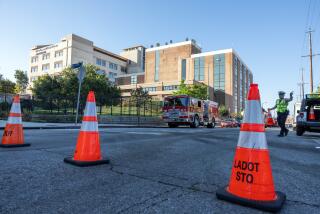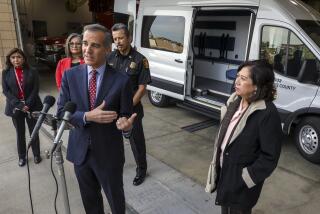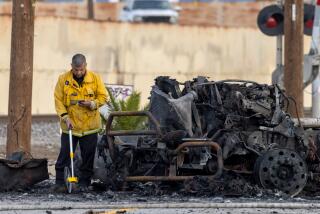Injured and ailing people wait as dispatch problems slow LAFD
When the machine swallowed her hand, slicing off one finger and mangling the rest, Tania Wafer’s co-workers tried frantically to stop the bleeding as a supervisor dialed 911.
Hang on, they told her as she slid in and out of consciousness on the floor of the printing plant. The ambulance will come soon.
It didn’t. Wafer waited nearly 45 minutes for Los Angeles Fire Department paramedics to arrive because of ongoing problems with the agency’s emergency dispatch system.
The dismemberment occurred March 7, when a brief equipment failure left dispatchers unable to alert fire stations. At a firehouse in Harbor Gateway near Torrance, just a mile from the bleeding woman, the alarms never rang, according to firefighters.
“I was in horrible, horrible pain,” said Wafer, 36, who was later told by a doctor that too much time had elapsed to reattach her finger.
Wafer’s case is one of several recent Fire Department dispatching problems compiled by The Times. The city Fire Commission has allocated emergency funds for technical experts who are trying to fix the glitches in a system crucial to tens of thousands of emergency responses each month.
Fire Chief Brian Cummings and Mayor Antonio Villaraigosa say that the city is safe and that rescuers will come when called. At a news conference last week, Cummings said the system is working properly “99% of the time.” And during the March 7 system breakdown, just two calls out of 1,000 were missed and no one died in either of those cases, he said.
But firefighters in the field say recurring problems have delayed responses to other emergencies in recent days, including a March 2 fire in South Los Angeles in which two people died.
The system problems have created confusion at station houses and have forced dispatchers to rely on antiquated backup plans, firefighters say. Bob Ashley, a dispatcher who has been with the department for 25 years, said that after several computer crashes in recent weeks, he and his colleagues tracked the availability of fire engines and ambulances with a peg board and golf tees.
The instability of the dispatch system, which officials blame on aging equipment and a move to a new building late last month, has prompted Villaraigosa to order a full review of the operation.
The technical failures are adding to questions about the department’s performance and transparency after The Times disclosed that for years, fire officials published statistics showing rescuers were responding to medical emergencies faster than they actually were.
Those numbers were included in reports that lawmakers considered when making deep cuts in emergency services last year. Several City Council members are now calling for audits of department data and probes of the public safety cutbacks.
Fire Commission President Genethia Hudley-Hayes complained that she learned that dispatch problems had affected emergency responses only last week, after reading about the news conference Cummings held.
The chief’s failure to tell the commission about the gravity of the problems was “a horrible breach of what should have happened,” she said. The commission will address response time statistics and equipment troubles at a meeting on Tuesday.
When the dispatch system works properly, fire stations are alerted by flashing lights, followed by an alarm that sounds over loudspeakers and a digitized voice that announces which personnel and units are needed, as well as the location and nature of the emergency. Station phones and bells also ring.
But at times, some or all of the notifications have failed, causing firefighters to waste precious seconds figuring out the location and type of emergency and who needs to respond, according to records and interviews. As a backup, fire stations have been ordered periodically to go on “radio watch.” That requires firefighters to monitor radio calls involving numerous stations for any incidents requiring their station to respond.
The night before the March 2 fire in South Los Angeles, firefighters at the nearest station to the scene said they went to sleep after receiving a department notice that radio watch had been canceled. According to the notice, a copy of which was obtained by The Times, firefighters were advised that the system’s voice notification “was intermittent and cannot be relied upon.” But in the event of an emergency, crews were assured, station lights would blink, bells would sound and dispatch phones would ring.
Shortly before 6 a.m., the lights flashed at Station 14, but the alarms were silent. Firefighters woke in confusion, not sure whether they had an emergency. “Everybody was kind of staring at each other,” said Freddy Purcell, a 23-year department veteran who was on duty.
Purcell slid down a fire pole as a Teletype machine printed the address of the fire on East Vernon Avenue, less than a mile away.
One firefighter tried to use the station’s loudspeaker to alert the rest of the crew. It wasn’t working either, so he ran upstairs and roused crew members.
Purcell and his partner rushed to the fire in their ambulance, arriving before other units. But they had no equipment to fight the flames that were tearing through the building.
The first firetruck — from another station — arrived more than seven minutes after the initial alarm, seconds before the engine from Station 14, according to dispatch records and interviews. The department’s goal is to be on fire scenes within five minutes 90% of the time. Even the slightest delays can mean the difference between life and death, officials say.
As firefighters shot water on the blaze, a woman appeared in a window. She was jerking desperately at a row of iron security bars, trying to break free.
“She was still alive when we pulled her out,” Purcell recalled.
The woman was pronounced dead at a nearby hospital. The next day, fire crews found a second body — a man’s — in the ashes. Firefighters suspect arson, and the coroner’s office said the woman’s death is being investigated as a homicide.
Those who battled the blaze, in a vacant building where transients sometimes stayed, said they will never know whether they could have saved the victims. But without the confusion caused by the malfunctioning alarm system, the fire engine from Station 14 could have been on the scene a couple of minutes sooner, according to firefighters at the station.
“We were delayed because of the dispatch,” said Greg Ikeda, a Station 14 firefighter. “It was not normal. That’s all I have to say.”
A week later, the alarms failed to sound at Fire Station 87 in the San Fernando Valley, according to a captain on duty, who said his crew lost about a minute getting to a fire that engulfed two condominiums.
Although no one was injured in that incident, “a minute is a long time if you’re a victim in a fire,” said Capt. Jeff Dapper, who was awakened by flashing lights and hustled to the Teletype machine to find out about the emergency.
On March 7, the day of the major system breakdown, an elderly man in San Pedro dialed 911 and said he was having trouble breathing, according to a Fire Department source who asked not to be named for fear of retaliation. At nearby Fire Station 101, firefighters were alerted to the emergency, but the computer on their truck transmitted only a partial address, sending them to a trailer park near the waterfront, the source said. The ambulance raced through the park with its sirens blaring, looking for the victim’s home, but returned to the station when they couldn’t find him.
It took nearly an hour — and another 911 call from the victim — before he was finally found and taken to a hospital, the source said. The department declined to provide information on the incident, or others included in this report, but the San Pedro patient survived, according to the department source.
On that same morning, Wafer’s hand got snagged in a binding machine at the printing plant.
As her co-workers gathered around, they wondered what was taking rescuers so long. Even her husband, who was asleep at the couple’s Wilmington home when he got the call, managed to get to the plant before paramedics.
Fire Department medics learned of Wafer’s crisis only after a plant worker eventually tracked down a phone number for the local firehouse and called directly. In the ambulance on the way to the hospital, the paramedics apologized to Wafer for not coming sooner.
“I waited so, so long,” said Wafer, a mother of four. “I could have stayed there dying, waiting for them.”
More to Read
Start your day right
Sign up for Essential California for news, features and recommendations from the L.A. Times and beyond in your inbox six days a week.
You may occasionally receive promotional content from the Los Angeles Times.








